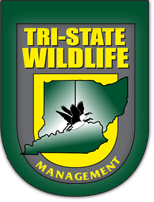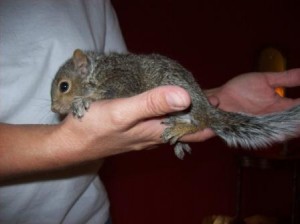Tri-State Wildlife Management is the best professional Cincinnati Squirrel Removal service provider. 513-853-0037 or 859-635-0037
Cincinnati Squirrel Removal – General Squirrel Information Grey squirrels are found throughout much of the eastern portion of the United States and Canada. They enjoy activity during the day, but are limited to the morning and evening on hot summer days. We in the Greater Cincinnati Area are most familiar with the grey squirrel; however, fox squirrels are abundant in our region as well. Squirrels are considered rodents, using their teeth much like a rat to gnaw/chew constantly. They need to gnaw to keep their teeth (incisors) worn down so that they do not grow into their jaw.
Squirrels live in dens in trees or shays (drays), which is a nest made from leaves and sticks. Squirrels do not hibernate, so they are active all winter. Favorite foods are acorns, walnuts and hickory nuts in the winter. If food is scarce, they will eat tree bark. Squirrels will eat tree buds in the spring and fruit and maple pods in the summer. Bird feeders are inviting “diners” for squirrels, as the birdseed is tasty and easily accessible.
Adult squirrels, usually at 1 year of age, begin breeding in January (give or take a month) and June (give or take a month), and bear their young during April and September (give or take a month for each). There are usually two litters annually. Litters typically consist of 3 – 4 kits. The kits stay with the female until they are 10 weeks of age. Tri-State Wildlife Management gets a large influx of calls from people with squirrel issues in the spring and in the fall because an attic is an attractive home for females looking to raise her young. In a forest habitat, when they leave the nest, they sometimes need to spread out to find suitable food; however, urban squirrels can and do find excellent living quarters and plentiful food available right where they were born, thanks to their human neighbors.
Squirrels become a nuisance when their eating habits and home choices conflict with humans. Homeowners can discourage squirrels by eliminating bird feeders and cutting back tree limbs (8’ from home) and entire trees. Keeping squirrels out of attics is the biggest problem facing the homeowner. Their constant gnawing can make a tiny hole a perfect entry point into the house. Squirrels living in an attic, ceiling or walls become more than a nuisance if the squirrel decides to gnaw on electrical wires. This is the number one reason homeowners remove the animal. Tri-State Wildlife Management is a full service company offering repairs and restorations for squirrel damage.
Because of expanding human populations reducing wildlife habitat and creating even more comfortable habitat, many species of wildlife at one time or another require management actions to reduce conflicts with people, property, and pets or with other wildlife species. In many cases wildlife species have found a way to co-exist with their human neighbors. Sometimes conflicts do arise and action is needed to protect the wildlife, humans, pets or property.
The goal of Tri-State Wildlife Management is to alleviate the problems that sometimes occur where wildlife and humans co-exist by providing information for homeowners to make good decisions to deter wildlife whenever possible. Sometimes wildlife needs to be removed when no other solution can be reached. Proper wildlife management and wildlife welfare are of the utmost importance.










